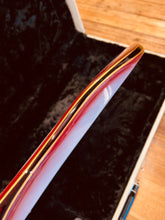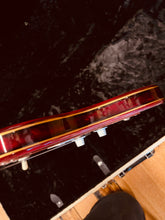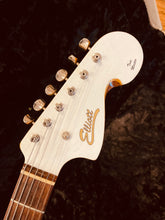
WOW!!!!! This Elliott Peter Stroud Tonemaster is a true gem, boasting a stunning nitro finish that is practically flawless. The custom wound pickups and impeccable fretwork are just a few of the hallmarks of this guitar's exceptional build quality. The playability and sound are simply amazing, making it a highly coveted instrument that often has a long waiting list for new orders. Fortunately, this has been very well looked after it look like it has barely been played, complete with a COA and original case. Don't miss your chance to own this sought-after guitar without the wait!
https://m.youtube.com/watch?v=I0xnUgcQHWQ&feature=youtu.be
The following information has been cut-and-paste from their website.
The Specs
Wood Selection
The wood is selected first and has to meet certain size and grain characteristics to assure all bodies are glued in the same manner, with an offset glue joint at the bottom bout of the guitar. This maintains consistency from one guitar to the next. The upper bout is contoured for a very comfortable feel. The species of wood used for this guitar body is Alder.
Bridge
The bridge options for the Tonemaster are:
-
Elliott hardtail
-
Super-Vee tremolo
The Neck
-
Flat-sawn solid Maple neck
-
Indian Rosewood fingerboard, International fingerboards are made with Pau Farro
-
Traditional clay marking dots
-
Our custom side dots
-
Nitro finish
Pickups
The pickups are custom wound in house to Peter's specifications. These pickups are very unique to themselves and have a huge tonal vocabulary. They have a very nice "tight" low end, smooth mid-range, and glassy high end without being harsh.
Bridge 8.6 ohm / Neck 7.3 ohm
Fretting
Our fretwork is one of the things we are most proud of. We go to the extreme to make sure that your guitar is going to play the best it can. The fingerboard is planed under tension. The fretting process is done with epoxy fretting. We use a special blend of epoxy that makes re-fretting very easy without messing up your fingerboard. This process is used for multiple reasons. One of the advantages to this type of fretting is that you lose the hollow gaps under the fret that you find with the traditional way of fretting. In traditional fretting, with each fret you put on, it is like driving a wedge into the fingerboard, which causes back tension on the neck. With epoxy fretting, all of these issues are eliminated. The epoxy under the frets helps to transfer string vibration throughout the neck to the body, and relieves all stress and tension on the neck that occurs with traditional fretting. This results in a stress-free neck, which allows the truss rod to work properly and to adjust the neck accurately.





































































